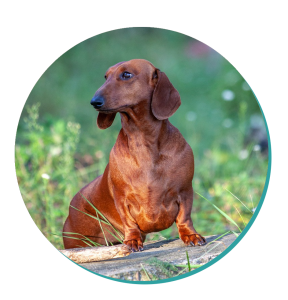You’ve seen them around everywhere, but how much do you know about the star of this Dog Breed Corner: the Dachshund? Learn more about the history, one-of-a-kind personality, and exercise needs of the Dachshund.
 Quick Facts ✔
Quick Facts ✔
Height – 18 – 23cm (13 to 15cm for the miniature breed)
Lifespan – 12 – 16 years
Country of origin – Germany
Breed type – Scent Hound
- Families with older children
- Apartment living
- Homes with other pets (especially other Dachshunds!)
- Owners committed to training
Breed History ♜
Dachshunds, or “badger hounds” in German, emerged as hunting dogs as early as the 15th century. These active little guys were perfect for taking on badgers; their great sense of smell, short stature, and large heart and lungs easily allowed them to sniff out and dig up badger holes. As soon as German breeders found out how special this dog was, they sought out different sizes. Through this approach, the Dachshund evolved to take on different animals, as small as the hare or as large as the wild boar. In Germany, there are three different size standards for the Dachshund.
Over the next few centuries, Dachshunds popped up all over the world with a variety of different colours and fur lengths. Today, there is an incredible diversity when it comes to the breed, from the smooth-haired to the wire-haired, two-toned black and red to dapple to piebald.
Personality, Traits, & Trainability ★
Although the Dachshund has given up its life of hunting, some of the personality traits live on today. Dachshunds are smart, confident, fearless, and a bit relentless. Owners should be prepared for a somewhat long training process, because these pups have a stubborn streak. That said, you’ll fall in love with their big personality. Dachshunds do well with other dogs and older children, and will assume the role of adorable “leader-of-the-pack” in no time.
Dachshunds benefit from rigorous mental stimulation and play, and Owners should strive to give them an hour or two of outdoor activity every day. While they’re not built for long-distance running, they still have plenty of energy that they need to use up so that they don’t take to destructive digging behaviours at home.
You can make them extra happy by giving them opportunities to burrow and snuggle into blankets. In fact, you’ll often find your Dachshund trying to weasel their way into the legs and arms of any clothing lying around, which is hilarious as long as you don’t mind a stretched-out sweater.
Health +
When it comes to health, the most important thing to keep in mind is a Dachshund’s fragile spine. Although some problems are related to genetic disorders, such as intervertebral disk disease, you can do your part to protect this doggo’s back by preventing them from becoming overweight. Also, make sure you always handle your pup with care. Because these dogs never back down, rough play, especially with children, can be very dangerous to a Dachshund.
Some other health issues that may pop up are hip dysplasia and patella luxation (a knee disorder), two joint-related disorders that may be the result of the Dachshund’s short stature. You can help to prevent them through highly-nutritious foods during your puppy’s early months. Also, make sure your pup regularly exercises, but avoids exercise that puts undue stress on the hip joints, like jumping.
Finally, Dachshunds sometimes experience eye problems, especially in older dogs. To offset this, make sure to take regular trips to the vet.
Fun Fact ♥
Dachshunds made history by becoming the first official canine mascot of the Olympics in 1972. All over Munich, and the rest of the world, Waldi the Dachshund inspired many to run faster, jump higher, and go for gold. Organisers even held the Olympic Marathon in the shape of a Dachshund!

